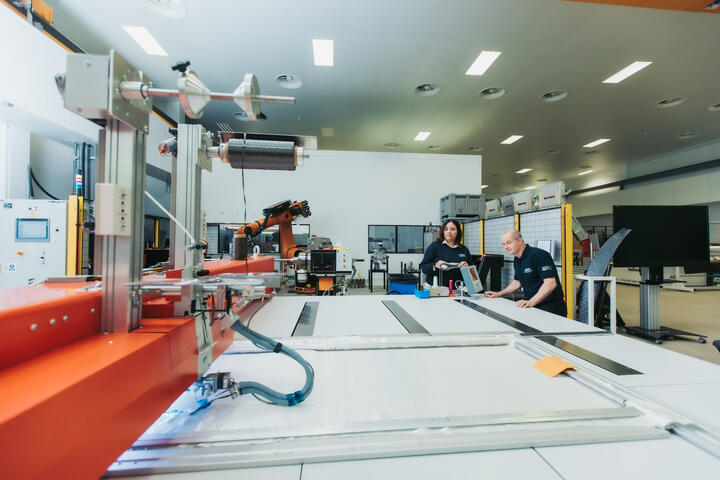Collaborative working optimises Tailored Fibre Placement capabilities for industry
Challenge
To analyse and accelerate future development of Tailored Fibre Placement (TFP) capabilities, in a bid to attract wider UK industrial interest within the aerospace and defence sectors and develop a strengthened business case to open up further opportunities.
Background
The University of Sheffield Advanced Manufacturing Research Centre (AMRC) and the National Composites Centre (NCC), are both working on developing Tailored Fibre Placement capabilities – which is a textile manufacturing technique based on the principle of sewing for a continuous placement of fibrous material for composite components. However, both centres have different manufacturing and modelling expertise, alongside the use of different technologies.
The two centres saw an opportunity to collaborate on a joint project to develop this research area, after seeing an insufficient transfer of know-how from existing TFP knowledge, as well as a lack of commercial performance data and robust studies on TFP materials performances, which has limited its uptake in higher technology readiness level (TRL) research projects and slowed down its development.
Both the AMRC and NCC saw the TFPs potential in delivering cost-effective, highly customised preforms, and an increasing number of industries have shown an interest in this technology in different areas. Industrial partners had also previously contacted both centres enquiring about a roadmap for TFP focus areas, including a business case from a production perspective, manufacturing data and optimisation data.
This work was funded by the High Value Manufacturing (HVM) Catapult, as both organisations are a part of the same Catapult network.
Innovation
To accelerate future development and attract industrial interest of TFP capabilities, the AMRC and NCC worked collaboratively to understand the manufacturing/designing properties and current challenges to such technologies as well as share expertise and knowledge.
Both centres recognised the difficulty for TFP to be competitive with other technologies that have already established structural analysis. There is also still minimal experience with optimisation and a lack of a full TFP part in the UK market.
This project looked to accelerate the future development of TFP, attract industrial interest and create a strong business case for the TFP capability.
A SWOT Analysis was the first step towards identifying the gaps and sharing information, including specs of each technology and each centre’s progress with the capabilities. It presents the current capabilities of the centre, the work undertaken to date, identifies the strengths and weaknesses of the TFP process, as well as opportunities and barriers to exploitation.
Reciprocal visits, including demonstration of the design software and machine manufacturing were completed. A demonstrator of a flat bike pedal was produced by each centre where a comparison was conducted between each of their TFP preforms.
Result
The SWOT analysis showcased that both centres acquired strong knowledge and design capabilities for the TFP, but that they excel in different aspects. The NCC has been working on the optimisation of the fibre path and building up an initial model to predict the failure. The AMRC has been developing manufacturing expertise, testing infused/injected TFP components and highly customised multifunctional preforms using different embedded sensor systems.
In addition, a TFP demonstrator part was created using a flat bike pedal geometry. This allowed a comparison between the catapult centres’ design strategies and allowed them to learn how to translate a design from one piece of equipment to another and identify key parameters in the manufacturing process.
The demonstrators’ work on the bike pedal significantly helped to understand and compare the capabilities of each machine, design software and its particularities. It highlighted the difference between the Catapult centres’ design strategies that resulted in having some distinct guidelines.
The same CAD design produced different TFP designs and later, the same TFP design reacted differently from a ZSK machine to a Tajima machine. The AMRC and the NCC both learnt from this demonstration on how to translate a design from one piece of equipment to another, as well as the significance of some parameters in the manufacturing process.
Impact
This project has enabled a better collaboration plan with the NCC as both centres’ expertise is complementary and there is a significant gap to fill in the market. The collaboration under the HVMC banner ‘one step closer’, is aiming to steer more attention and engagement toward the TFP capability and its potential.
One of the weaknesses that was identified for both centres is the insufficient transfer of the know-how from existing external TFP knowledge. This is the reason why this type of collaboration is necessary to increase more awareness and expertise about this capability and support the UK market to be a leader in innovative manufacturing.
Both centres have found the value of sharing and extending their expertise to be able to further extend support to the UK composites market.
Thanks to the collaborative work on this project, both the AMRC and NCC are encouraged to work together on future collaborative projects, which will enable both centres to showcase the capabilities of the overall catapult centre system and to further develop their combined knowledge in composites.
The two centres are now looking into the high-rate production of the TFP both inside and outside of the UK.
For further information, please contact Fatma Omrani, technical lead, composites:
T: 01142 158091 E: f.omrani@amrc.co.uk
Or Christopher McHugh, dry fibre development manager, composites:
T: 01142 227674 E: c.mchugh@amrc.co.uk


